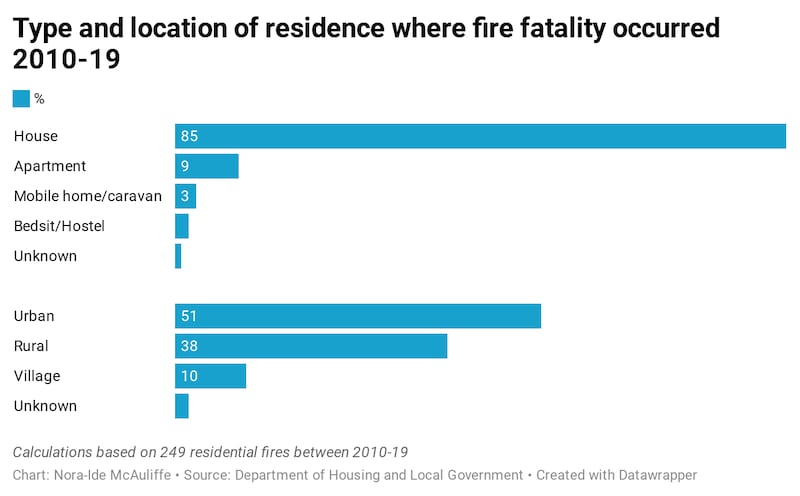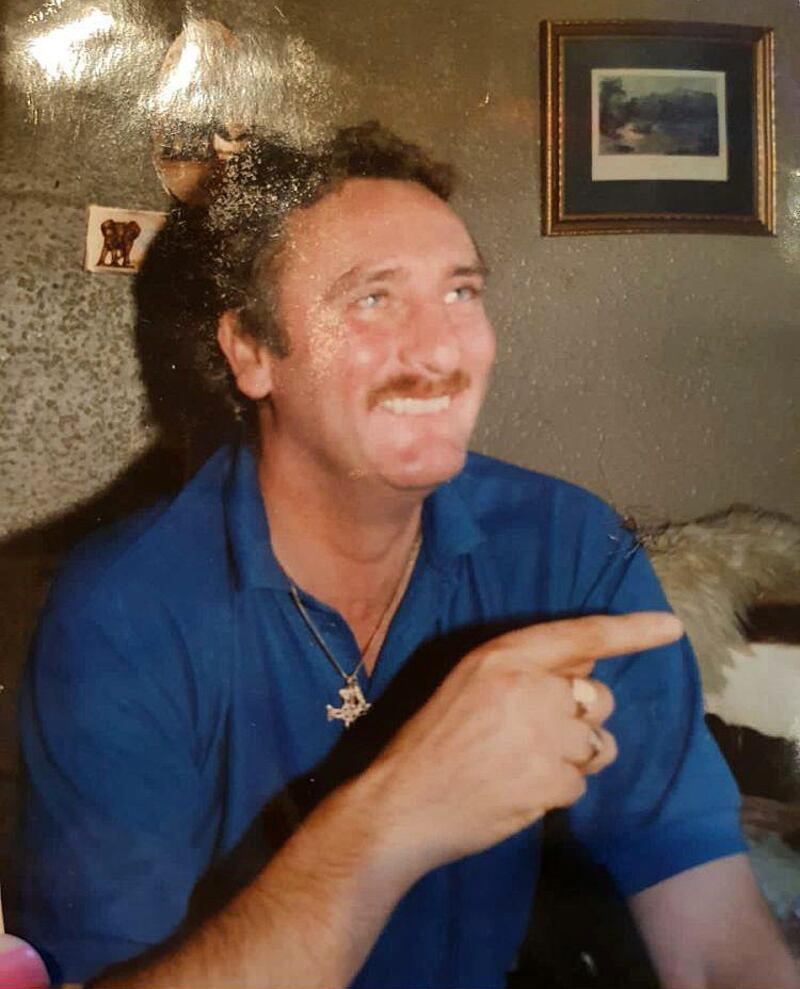Nearly 40 per cent of people who died in fires in homes across the State in the past decade lived in properties that did not have smoke alarms, an Irish Times data analysis has found.
However, the true figure could be even higher as some properties were so badly damaged during the blaze that the fire brigade could not tell if the home had a fire alarm or not.
In all, 277 people died in 249 residential fires in houses, apartments, mobile homes/caravans, bedsits and hostels, with the majority dying alone, though there were some incidents which involved multiple fatalities.
A smoke alarm was present in the case of 88 residential fires in which a total of 99 people died, according to data from 2010-19 collected from fire brigades by the Department of the Environment, Housing and Local Government. However, 21 of the 99 died where a smoke alarm, although present, was not working.
In a further 21 of these cases, it is unknown whether the alarm present was working, as the damage was too severe to ascertain.
In 59 house fires, in which 72 people died, the damage was too extensive for the fire brigade to determine whether there was a smoke alarm present or not.


Ninety per cent of people say they have a fire alarm, says Seán Hogan of the National Directorate of Fire and Emergency management team. However, they have to be put in the right places.
“We have found [that] the best of systems are put in, but people are taking them out because they are smoking indoors, doing cooking indoors, etc. It’s a mismatch between safety and lifestyle.
“Sometimes people take out the battery because they are causing what is perceived to be a nuisance alarm and that’s generally to do with the alarm being in the wrong place” (ie near a toaster, etc), he says.
People do not appreciate how quickly a room fills with smoke, even from a small fire, Hogan says. If someone is in a room where a fire starts, the chances of coming out of it are very slim without an alarm.
Victims of fatalities
The data analysis shows almost half (48 per cent) of all fire deaths from 2010-2019 were among those aged 65 and over. Two-thirds of all those who died were men.
Six in 10 fires started between 6pm and 6am, and almost one-third between midnight and dawn. December (33), January (31) and October (24) were the months with the highest number of fatalities over the nine-year period.

A study published last year by the Health Research Board (HRB) of 101 fires that led to 106 deaths in 2014-2016 found alcohol played a role in many of them.
Toxicology reports were available for 91 of those who died and just over half had alcohol in their blood. Nearly two-thirds (64 per cent) had alcohol levels three times above the legal driving limit.
Such intoxication would, at this level, affect “stage balance, co-ordination and possible loss of consciousness reducing ability to respond to fire”, the report notes.
Sixteen of the dead would have found it difficult to escape because they used a walking stick or frame, wheelchair or were otherwise immobile, the HRB study reported.
A small number of those who died had other disabilities, such as poor eyesight or hearing. Of this group with mobility issues, 75 per cent were 65 years or older.
Causes
Fire brigades identified the suspected cause of 101 of the 249 fires that led to deaths since 2010 – with 18 blamed on cigarettes and the same number caused by electrical appliances.
Electrical wiring was blamed for 14 deaths, while gas appliances were linked to five more. Last year, four deaths were blamed on cigarettes; two on electrical appliances; and one on a pot on the cooker.

Some 80 per cent of the fatal fires happened in houses, 9 per cent occurred in apartments, while mobiles homes and caravans, and bedsits and hostels accounted for 3 per cent each.
Over half (52 per cent) of the fires took place in towns or cities; 38 per cent happened in country areas; while a tenth occurred in villages. The location of four more was not listed.

However, there are signs that homes are becoming safer. Fifteen people died in fires in the home in 2018 and 2019 – the lowest annual death rates on record in the State. While 2017 saw a spike, the general trend is downward.
Fire deaths in Ireland now stand at 5½ fatalities per million people, making Ireland one of the safest countries globally. "There is a handful of countries which would be under four fatalities per million.
“We are heading in that general direction and hopefully we will stay there,” says Hogan, adding that better-built properties, public safety campaigns and smoke alarms have all helped greatly.
Case study: Much-loved father dies in house fire with childhood friend
“A brilliant ballad singer, that was his wonderful talent in life. That’s the main thing about my dad, the neighbours would compliment his singing,” says Sinéad Mangan of her father Derek who died in a house fire earlier this year.

Derek was also a keen banjo and spoons player and in his earlier years had travelled all over the country performing. Such was his voice that Cyril Cusack asked him to record some songs for him, and Sinéad was named after the Irish actor’s daughter.
A roofer by trade, Derek grew up in Drimnagh in Co Dublin and was an avid fisherman, gardener and “a proud family man”. He was a fantastic father to his four daughters and son, and Linda - his wife of 42 years - was his soulmate. “They were inseparable,” says Sinéad.
Derek (72) died in a house fire in May with his childhood friend Joseph Muldowney who also lived in Drimnagh. It is not yet known how the fire, which broke out at Joseph’s house at about 1pm, started. “On that particular day he brought food to Joseph - bacon, ribs, coffee and the paper as he did the Thursday before his death during lockdown. He left the house early, ran a few errands and left his phone behind him so my mother knew he wouldn’t be gone long. He never returned, we never saw him again and DNA had to be taken to identify his body,” Sinead says.
Derek was very close to all of his eight grandchildren and enjoyed taking them to the mountains and rivers and telling them all about Ireland. “He had special things he did with all of them and they miss him terrible,” Sinéad says.
He loved measuring his height against his first grandson Christian, who he helped rear and in the week leading up to his death he had made his granddaughter Beaux a hanging plant in his back garden. He had also just taken a socially distanced photograph with his other grandchildren Sean jnr and Lenny. He loved spending time with his granddaughter Deliah and been due to go on a fishing trip with her brother Oliver the weekend of his death.
“He would visit my sister Erica in Devon where she lives with her two children Samuel and Scarlett and he missed his trip to her over Covid. He FaceTimed with them every single day.”
In 2016, Derek underwent gruelling radiotherapy for prostate cancer and was cancer free at the time of his death.
“It is six months down the line now and the loss of him is still hard to bear. Even the children on the road in Benmadigan miss him greatly and his presence is, and will never be, forgotten.”









